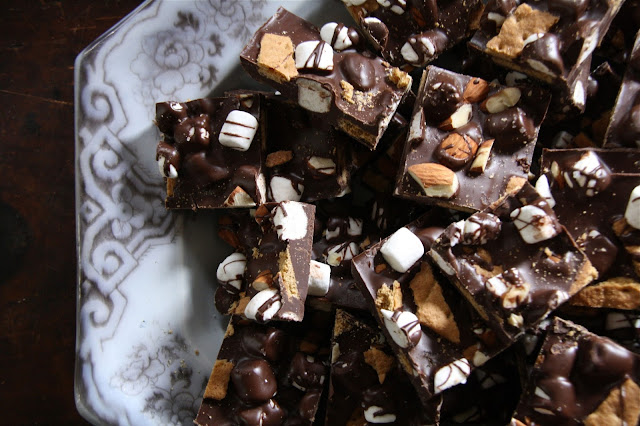
Last week I felt the need or rather had a strong urge to make some scones. I had gotten it in my head that a brunch would not be a real brunch without scones. However, the brunch without them happened. In retrospect, this was a mixed blessing. Had I gone forward with the scone recipe I had intended to make, I would not have made THESE. And I definitely would not have spent hours of my life reading even more scone recipes. What would cause me to become so scone recipe obsessed? Well, I started to second guess my initial scone recipe choice. While entrenched in the scone recipe world, I came to realize there didn't seem to be any crystal clear butter to flour or dry to liquid ingredient ratios. And then, to make it a bit more frustrating, recipes calling for 2 or 3 cups of all-purpose flour all called for using one tablespoon of baking powder. My quest to find the 'perfect on the first try' scone recipe was making my head spin. Not to allow all of the time invested in scone research to go to waste or worse yet, turn into recipe paralysis, I ended up doing what I usually do. Trusting and listening to my instincts (which have been known to fall somewhere between 95% and 100% of the time). In this case it meant incorporating techniques and/or ingredient amounts from one recipe into another based on what made the most sense. And then keeping my fingers crossed this would not be one of those times when I got it completely wrong.

The time spent on the deep dive into the scone world resulted in THESE Mixed Berry Scones. On a side note, they can also be made into blueberry scones, single berry scones, or plain no berry scones. But since I had my heart set on Mixed Berry Scones, Mixed Berry Scones it was going to be! Even if that meant making another trip to the grocery store shamelessly dripping wet after an hour long hot yoga class. There are probably grocery store rules prohibiting people from entering the store looking as I did, but they weren't posted anywhere and none of the grocery store employees would be comping my grocery bill.

The recipe for these Mixed Berry Scones ended up being a hybrid version of two scone recipes: The Royal Wedding Scones (shared by a community member on the Food52 blog) and the Mixed Berry Scones shared in the September 2015 issue of Cook's Country. In case you are wondering, it leans much closer to the Royal Wedding Scone recipe. The idea of using less butter and heavy whipping cream versus more butter and whole milk was what swayed me. I am easily tempted by anything with heavy whipping cream in it. If anyone called me a whipping cream slut I would take it as a compliment.

Scones are rustic, crumbly, buttery, slightly on the dense side, and have a less discernible flaky layer. While sometimes referred to as a biscuit-like pastry, they are quite different than a biscuit. At least the American version of a biscuit. Scones can be round, triangular, or square (there don't seem be any shape rules for them although some scone purists might tend to disagree). They can be eaten plain or slathered in butter, jam, preserves, lemon cured, or clotted cream. The origin of scones has been attributed to Scotland. Primarily due to a 1513 print reference. Ironically not in the form of a recipe, but in a poem penned by a Scottish poet. England and Ireland have also laid claim to being the ones to create the first scone. Considering there were very few culinary outlets back in the 16th century, it is quite possible any of the three could hold the title of Scone Creator. Over the past five centuries the scone has undergone various iterations. From shaped as round cakes to wedges, to being made with oats to being made with flour, to being cooked over an open fire to being baked in an oven. The scones originally eaten at the end of the Medieval Age are a little different than the ones we are eating today.

Well chilled butter and frozen fruit are key in the making of these scones. To minimize the bleeding of the frozen fruit into the dough, toss them with a tablespoon of confectionary sugar and return back to the freezer while you are measuring out your other ingredients.
The dry ingredients (flour, sugar, salt, baking powder) come together in the food processor with a few quick pulses. That very well chilled butter is added and pulsed (10-12 times) until it is transformed into pea sized pieces. If you over process the butter, your baked scones won't have those heavenly biscuit-like butter pockets. Transfer the dry ingredients to a large bowl, then toss and mix in the frozen fruit. Make a well in the center of the mixture before adding the liquid.
After whisking the heavy cream, egg, and vanilla together, pour into the well you have created.
Begin bringing the dough together with a large fork. Think folding rather than stirring here. When the dough begins to gather, use a plastic dough scraper or spatula to gently knead the dough into a ball. If by chance there is any flour remaining on the bottom of the bowl, drizzle in a tiny amount of heavy cream (a teaspoon at a time) until it all comes together. Don't panic if your dough takes on a pink or blue color, it will work itself out when the scones are baked in the oven.
On a lightly floured surface, turn out the dough. Gently pat into a 12"x4" rectangle. Using a sharp knife, cut the dough into 4 equal rectangles. Then cut each rectangle diagonally into 2 triangles. Alternately shape the dough into a 6" or 7" circle. Whether you make a rectangle or a circle, you want to end up with 8 scones.
Place on baking sheet, tightly cover with plastic wrap, and place in the freezer. Yes, I know, making you wait to bake them sounds like some Medieval form of cruelty. The freezing process doesn't sacrifice the flavor or texture of the scones. Instead it seems to enhance them. And just think, if you make the scones the night before, all you have to do in the morning is make some coffee or tea, preheat your oven to 425 degrees (F) and get the scones ready to go into the oven. And you won't have a mess in your kitchen to clean up!
The scones rise and expand during baking so place your frozen scoens at least one inch apart on your parchment paper lined baking sheet. Brush each one with heavy cream (yes more cream) and liberally sprinkle with sanding or other coarse sugar. The scones bake for 20-26 minutes. Rotate the pan halfway through the baking process.
And as if by magic, you will end up with the most beautiful golden brown scones.
Transfer the baked scones to a wire rack and allow to cool for at least 10 minutes before serving.
These scones are buttery, have the most tender crumbs, are the right kind of firm, have a crisp sugary crust, and are perfectly moist. They are definitely not those dry, hard scones better used as door stops. No, these are 'shut the front door' amazing! These are substantially sized scones. Although the likelihood of you not being able to finish these 'leave no crumb behind' scones in one sitting isn't very high.
Serve the scones with butter, jam, lemon curd or clotted cream. Or simply eat them plain. Everything about these Mixed Berry Scones is perfect. And yes, if there will be any scones at the next brunch it will only be THESE.
Recipe
Mixed Berry Scones (a bit of blending of the Royal Wedding Scones recipe from Scone Lady Mrs. Larkin shared on Food52 and the Mixed Berry Scones recipe from the September 2015 issue of Cook's Country)
Makes 8 scones
Ingredients
2 1/2 cups (320 grams or 11.25 ounces) all-purpose flour
1/4 cup (50 grams) granulated sugar
1 Tablespoon baking powder (See note)
3/4 teaspoon kosher salt
6 Tablespoons well-chilled unsalted butter, cut into small cubes
6 to 8 ounces frozen mixed fruit (See note)
1 Tablespoon confectionary sugar
1 cup heavy cream, plus more for brushing the tops of scones
1 large egg
1 1/2 teaspoons good quality vanilla
Sanding or other coarse sugar for finishing
Directions
1. Toss the frozen mixed fruit with the confectionary sugar and return to the freezer.
2. Place the dry ingredients in the bowl of food processor fitted with the blade attachment. Pulse to combine.
3. Add butter. Pulse 10-12 times until the butter is reduced to pea-sized pieces. Transfer mixture to a large bowl. Stir in frozen berries.
4. Whisk the whipping cream, egg, and vanilla until well-blended. Make a well in the center of the flour mixture and pour in cream mixture.
5. Using a large fork, fold the wet and dry ingredients together. When the dough begins to gather, use a plastic scraper (or spatula) to gently knead the dough into a ball shape. If there is any loose flour on the bottom of the bowl, drizzle in a little more cream, one teaspoon at a time, until the dough comes together.
6. Transfer the dough ball to a lightly floured board. Gently shape into into a 12" by 4" rectangle. Using a knife, cut the dough crosswise into 4 equal rectangles. Cut each rectangle diagonally into 2 triangles for a total of 8 scones.
7. Transfer cut scones to a baking sheet. Cover tightly and place in the freezer until frozen.
8. Preheat oven to 425 degrees (F). Place frozen scones about 1 inch apart on a parchment paper lined baking sheet. Brush with cream. Liberally sprinkle tops of scones with sanding sugar.
9. Bake for 20-27 minutes, turning the pan halfway through. Scones are done when an inserted wooden skewer comes out clean. Transfer scones to a wire rack and let cool at least 10 minutes before serving.
10. Serve with butter, jam, lemon curd, or clotted cream.
Notes: (1) When baking, King Arthur Flour and Kerrygold Unsalted Butter are my preferred favorites. (2) If using Rumford baking powder, the scones will not rise during the baking of the frozen scones. (3) If using mixed berries that include strawberries, cut the strawberries in half. (4) Instead of Mixed Berry Scones, make Blueberry Scones. Use 3/4 - 1 cup of frozen blueberries, preferably the smaller wild Maine blueberries. (5) Stored in a plastic freezer bag, the frozen unbaked scones can be stored in the freezer for several weeks. (6) The scones can be baked immediately and do not absolutely need to be frozen before baking, however, I would highly recommend the freeze and bake method. (7) Any leftovers can be rewarmed in the microwave for 15-20 seconds. Baked scones can be frozen. Reheat in a 350 degree (F) oven until warm.
A walk through the woods on an early spring day in March, 2017 (Fullerburg Woods)



















































